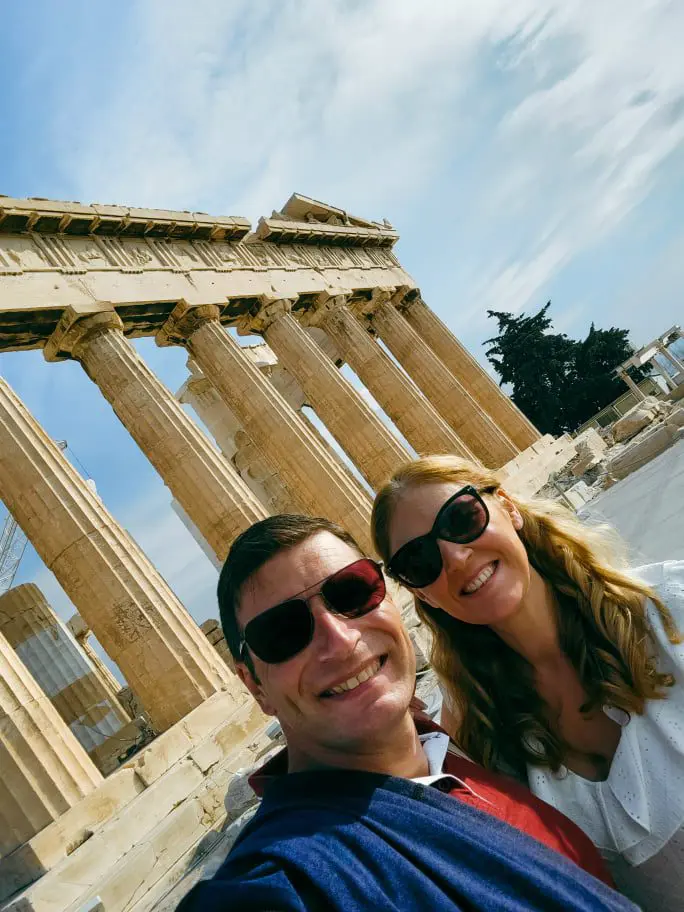 The majority of us have one tourist attraction in mind when we book our trip to Athens and that is the ancient monument the Acropolis. When you arrive, you’ll be astounded by the fact that you can see this beautiful citadel from most neighbourhoods in the city. As well as being the centrepiece of Athens, it is a constant reminder of how the old and new combine.
The majority of us have one tourist attraction in mind when we book our trip to Athens and that is the ancient monument the Acropolis. When you arrive, you’ll be astounded by the fact that you can see this beautiful citadel from most neighbourhoods in the city. As well as being the centrepiece of Athens, it is a constant reminder of how the old and new combine.
We’re sure that if you’re planning a trip, you will be eager to get the most out of your time there. Preparation is always the key to a great experience when you travel, so we will tell you everything you need to know within our guide to the Acropolis.
Once you’ve read this guide, you’ll have a greater idea on buying tickets, what’s available on and around the hill such as the facilities, and our top tips on what to do when you’re there.
Ad Disclaimer!
This website uses paid adverts and affiliate links, these come at no additional cost to you and help us to fund the operation of the website, meaning we can continue to provide you with valuable content.
The money received from these links and adverts do not influence any recommondations made within our content.
Page Contents
What is the Acropolis – A Brief History
You will find the Acropolis on a rocky limestone hill, which is poignant because the word ‘Acropolis’ is Greek for ‘highest point’; which it certainly is. There are many other acropoleis in Greece, but this one has become the most famous and rightly so.
The Acropolis mound homes a number of ancient buildings, with the most famous being the Parthenon. Here is a list of the structures you can expect to see.
- Parthenon
- Old Temple of Athena
- Erechtheum
- Statue of Athena Promachos
- Propylaea
- Temple of Athena Nike
- Eleusinion
- Sanctuary of Artemis Brauronia
- Chalkotheke
- Pandroseion
- Arrephorion
- Altar of Athena
- Sanctuary of Zeus Polieus
- Sanctuary of Pandion
- Odeon of Herodes Atticus
- Stoa of Eumenes
- Sanctuary of Asclepius
- Theatre of Dionysus Eleuthereus
- Odeon of Pericles
- Temenos of Dionysus Eleuthereus
- Aglaureion
It is believed that people lived on the area of the hill since the 4th millennium BC, but that the buildings we see today didn’t begin construction until the 5th century BC. During this time, known as the ‘Golden Age of Athens’, a Greek statesman known as Pericles coordinated the construction of many of the buildings we consider to be the most important, such as the Parthenon and Temple of Athena Nike.
Most of you will be aware of the Parthenon because it is one of the most famous structures in the world. It is the main building that you can see from a distance, and it is incredibly striking when you stand within the grounds of the Acropolis. The Parthenon was built as a tribute to the Greek Goddess Athena Parthenos, who is claimed to have won a contest against Poseidon for patronage of Athens. Both wanted control of the great city and so it was decided that each would bestow a gift and the king of Athens Cecrops would decide which was more valuable to the people.
Poseidon struck a rock with his trident and created a salt spring to give the Athenians access to trade and water. But because the water was salty it was undrinkable for the people, although there is an alternative story that he gave them their first horse.
Athena is said to have touched her spear to the ground and from that an olive tree appeared. She was declared the winner because the tree brought food, oil, and wood. As such Athena’s olive tree is seen as a symbol of Athens economic prosperity.
The Parthenon has been a Christian church and an Islamic Mosque, but sadly it was destroyed during a war between Venetians and Ottomans.
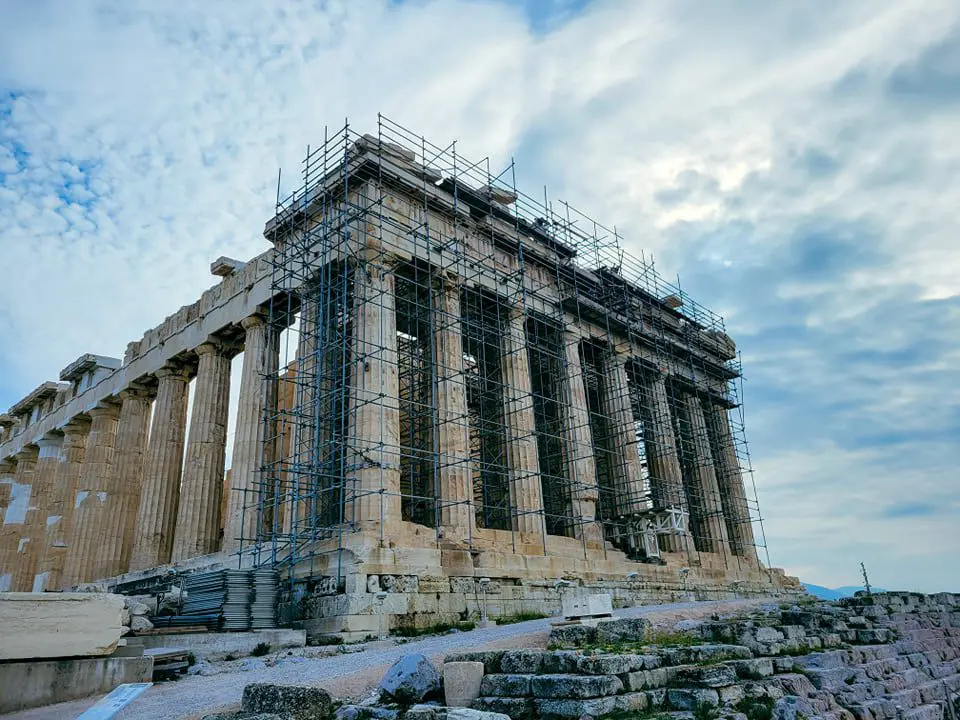 From 1975 there has been extensive renovation and building work on the Parthenon, which is something you will see upon your visit. Sadly, you may not experience the picture-perfect scene you were expecting, because there will be scaffolding, cranes and workers mulling around the site. During our visit an entire side of the Parthenon had scaffolding over it, but we realise the work is essential to restore the monument to its heyday.
From 1975 there has been extensive renovation and building work on the Parthenon, which is something you will see upon your visit. Sadly, you may not experience the picture-perfect scene you were expecting, because there will be scaffolding, cranes and workers mulling around the site. During our visit an entire side of the Parthenon had scaffolding over it, but we realise the work is essential to restore the monument to its heyday.
You will find that many of the artifacts from the Parthenon and the surrounding temples, have been moved to the Acropolis Museum. So, ensure you take some time to visit the museum for a complete experience of what the site would have looked like.
Tickets to the Acropolis and Parthenon
This can get a little complicated because we have three routes you can take when purchasing your tickets. We personally chose to buy an attraction pass called the ‘Turbopass’, but we’ll go into that in detail a little further on in the guide.
Acropolis Only Tickets
You may only have a small period of time in Athens, so if you’re only going to visit the Acropolis then you can buy tickets online or at the attraction. Make sure you consider how busy it will be when purchasing your tickets. For example, if it’s summer then you may be best buying the tickets online before you get there so you don’t have to queue.
Ticket Prices
Summer – April 1 to October 31 – €20
Winter – November 1 to March 31 – €10
When you go onto the Acropolis site to book tickets, you will see a variety of options which you can add on, including skip the line and audio guides. We went in November so the skip the line option wasn’t needed, but between May to September it can get quite crowded.
Combination Ticket
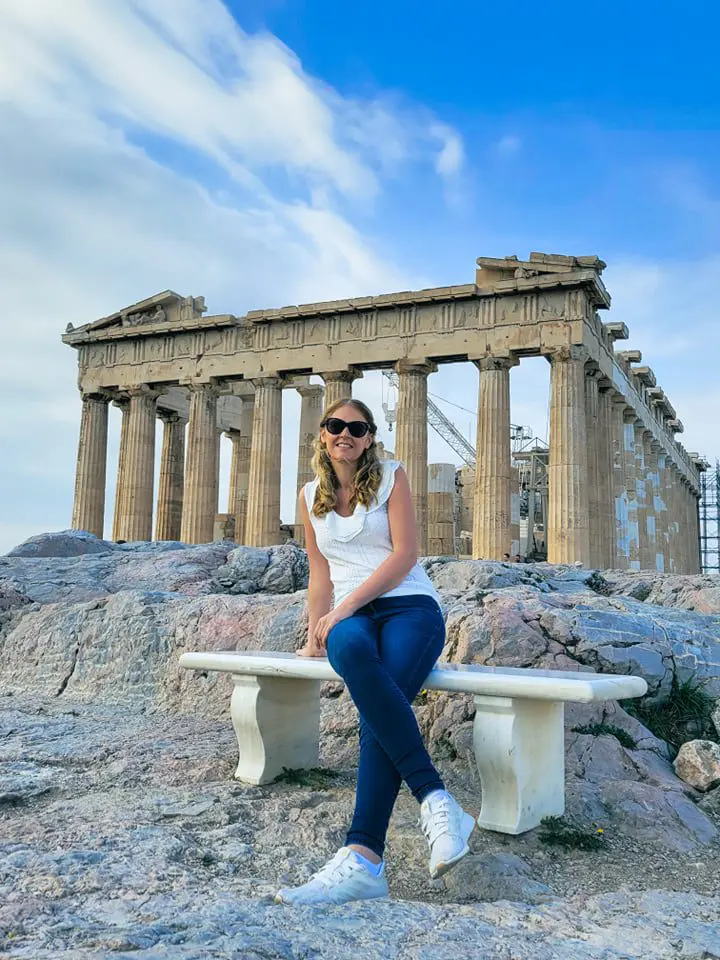 Ticket Price – €30 All year round
Ticket Price – €30 All year round
If you’re planning on doing a few of the archaeological sites in Athens, then this may be the better option for you, value wise. By purchasing this ticket, you will get admission to:
- The Acropolis
- Hadrian’s Library
- The Ancient Agora
- The Roman Agora
- Kerameikos
- Lyceum – Aristotle’s School
- Temple of Olympian Zeus
What makes this better is the fact that it offers the ability to skip the line at each attraction. This will obviously be more valuable within the busier months, because when we visited (November), we pretty much walked into everything.
The combination ticket is valid for five days from the date you first use it and you can only access each attraction once.
Turbopass – Athens City Pass
Whenever we book a city break, our first task is to see if they have an attraction pass. We have used attraction passes in many many places, such as Rome, Barcelona, Boston, New York and Las Vegas.
The key to deciding which ticket option you want (single, combo or pass), is by considering how many attractions you wish to see and how many days you have in Athens. If you’re there for the day and you’re pretty mobile, then you can get most of the archaeological sites done, so a combination ticket may be worth your while. But if you’re there for three or four days then the Turbopass may be the better option. The best part of the Turbopass is the fact that you buy it and then you don’t have to spend any money when you reach each attraction. That leaves you with more money for those tourist nik naks we all love.
Don’t get us wrong, we have bought passes in the past and they haven’t been worth it for us. More so if the attractions are difficult to get to or you don’t really fancy the places on it. We had that experience in Miami and because we didn’t trigger the pass, they gave us a refund. But there have been some cities where we have visited more attractions than we would if we were paying on the door and those tours are now our fondest memories. The first step is always looking at the list of free entry attractions with the pass and deciding how many you would do and if it is worth the money.
Anyway, this is how the Turbopass works:
- Choose how many days you want the pass for, this can be 1, 2, 3, 4, 5 or 6 days – You should be aware that the passes are for full days only, so if you start a 1 day pass at 2pm on the Monday it will finish on the Monday night and not at 2pm on the Tuesday. If you’re in Athens for 4 nights, then it would be best to get a 3-day ticket.
- After you purchase the tickets then you will receive a confirmation via email. This will give you full details on each attraction and your tickets which will be split into general attractions and a special pass for the archaeological sites (pretty much the combination ticket).
- Within the tickets there is a QR code which you can either keep on your phone or print off. We choose to print it off and show the paper version when we’re entering the attraction. This will be scanned when you arrive at your chosen tour or museum and then you can enter, no parting with money because you’ve already paid (valid for ‘free entry’ options only).
- You can access each attraction once, but the more of them you visit, the more worth while the pass will be.
- Most of the attractions on the pass have a ‘skip the line’ option, which can be incredibly worthwhile in busier times of the year.
- Just make sure that the attraction you want to see is labelled ‘free entry’, because there are some on the pass which are discount only. Of course, if you really want to visit that attraction then the pass will still reduce your overall cost.
- In addition to gaining entry to the various attractions, the Turbopass also gives you 48 hours on the Gray Line hop on, hop off bus. You can use this as a way of getting from one attraction to the other, but in all honesty, Athens is an easy walking city so it probably isn’t needed. We just sat on the bus for a loop and took in the scenery.
- The pass will also give you discount on a number of tours, shops and restaurants such as the Hard Rock Café Athens, or the Athens Segway Tours.
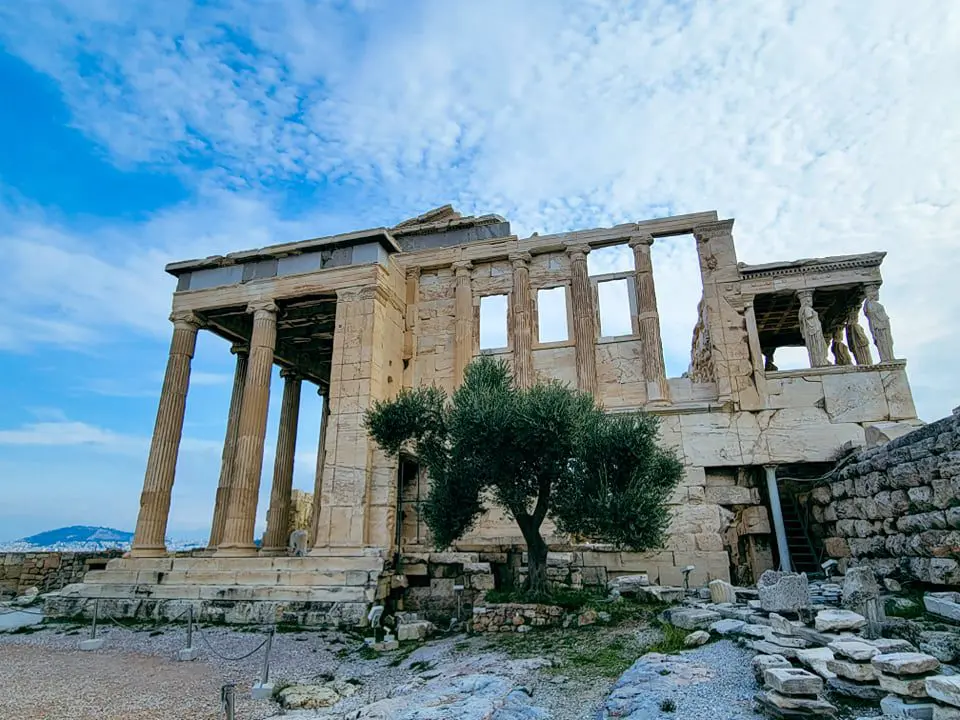 We paid about €66 euros for a 3-day pass, which included everything on the combination ticket and more.
We paid about €66 euros for a 3-day pass, which included everything on the combination ticket and more.
What ticket you choose is completely up to you, but you will want to consider how long you’re in Athens for, what you want to see and how mobile you are to walk around the city. There are a number of public transport options such as metro and bus, if you cannot walk very far.
Athens Acropolis Opening Hours
Opening hours will vary depending on whether you visit during the summer or winter season. This is the current information found on the Acropolis website.
Summer – 8am to 6pm (Last entrance 5.30pm)
Winter 8am to 5pm
The Acropolis closes on set days annually, they are 1 January, 25 March, 1 May, Easter Sunday, 25 and 26 December.
Facilities at The Acropolis and Slopes
Within the main entrance on the Western side of the Acropolis there is a ticket office, small café, shop, bag check and toilets. The toilets are a little hidden so just ask someone for directions, but they are clean and well maintained.
There is a lift on the side of the acropolis mound for those of you with mobility issues, who cannot climb the steps to the top. Simply ask for assistance from the ticket office and they will direct you.
How Much Time to Allocate for the Acropolis and Slopes
When you include the hill itself and the slopes, there is quite a bit to see, so in general we would say that you should give yourself a minimum two hours. If you have the audio guides, then you will probably take longer and of course it completely depends on the crowds. The more people you have to manoeuvre around, the longer it will take to see everything.
How to Enter the Acropolis Site
There are actually two entrances to the Acropolis, one on the western side which is the main entrance and a smaller one on the south-eastern corner. The main entrance can get incredibly busy, so the other ticket office may be a better solution for those of you travelling in peak season.
The south-eastern gate is also ideal if you are planning on visiting the Acropolis Museum after the site, as it is close by.
If you require the lift, then head to the north-eastern side to gain access to the entrance for wheelchair users.
Do You Need a Guide for the Acropolis?
We didn’t have a guide for the Acropolis, and we thoroughly enjoyed it, but we have had tour guides to other historic sites and we know how they can bring a place to life.
There are lots of signs in English and Greek around each site, explaining its historic importance. And we enjoyed the fact we could take our time and get the pictures we wanted without being rushed.
You can pay for an audio guide when you arrive at the site, which may be a faster option if you are time restricted. But it really is a personal preference and there are plenty of good quality guides you can prebook online.
Essentials for your Visit
The essentials you need will completely depend on the time of year you visit, but the first thing is a pair of good walking shoes. There is a bit of a hike up the hill, so you will want to make sure you are comfy. It can get slippery when it rains because most of the steps are marble, so make sure your shoes have decent tread on them. Also, the grounds on the hill are quite rubbly so it can be difficult to walk about.
If it’s peak season, meaning the summer, then it’s going to be hot, so plenty to hydrate you and sunglasses or a parasol because there is no shade up there. For the days when it is going to rain then you’ll need an umbrella and waterproof jacket. We visited on quite a sunny day, but there was a cool chill in the air, so we needed jackets with us to buffer the cold breeze.
Main Sights Within the Acropolis
There are two areas and that is the Acropolis itself and then the slopes around it. The main buildings on the Acropolis hill are the Propylaea, the Parthenon, the Temple of Athena Nike and the Erechtheion. Around the slopes is the Theatre of Dionysus and Odeon of Herodes Atticus.
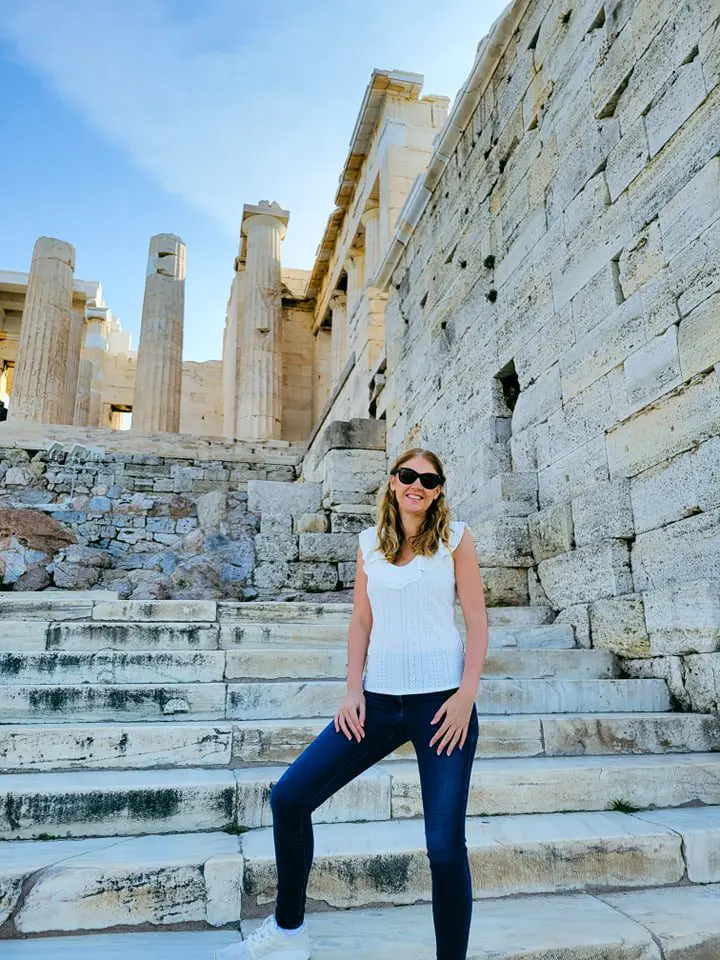
As you climb up the slope to the hilltop, the Propylaea is the first structure you will see. It is the gateway and main entrance to the grounds. It is made of marble and has those iconic columns leading us into the Acropolis.
Parthenon
The Parthenon is a temple dedicated to the Greek Goddess Athena and is the main reason why most of us visit the Acropolis. Positioned in the centre of the hill, you can walk around the structure but sadly not in it. There will be lots of work happening within the Parthenon itself and around the outside. When we visited one side was completely covered in scaffolding. Even with the renovation work, it is an incredible sight to behold and well worth the climb to the top.
Temple of Athena Nike
Dedicated to the goddesses Athena and Nike, this temple was the first fully Ionic temple on the Acropolis. It is positioned next to the Propylaea and has been completely renovated.
Erechtheion, Pandroseion and the Old Temple of Athena
On the other side of the Acropolis are the Erechtheion, Pandroseion and the Old Temple of Athena. They give the appearance of being one building when in fact they are three. This is said to be the spot where Athena and Poseidon fought for patronage of Athens. Athena won by creating the first olive tree and you will see that tree beside the Erechtheion.
On the old temple of Athena, you will see what are known as caryatids, which are six female statues who are there to support the roof of the front of the temple.
Acropolis Viewpoint
On the eastern end of the Acropolis is an elevated viewpoint and the Greek flag, which is ideal for those perfect pictures of Athens below.
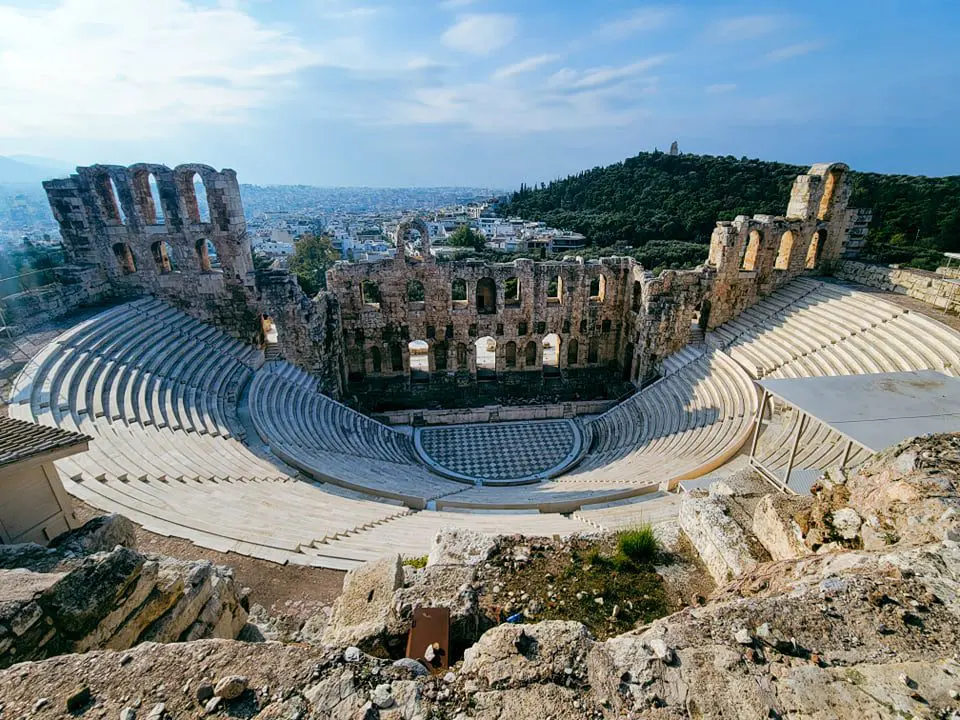 Theatre of Dionysus
Theatre of Dionysus
The Theatre of Dionysus was one of the world’s first open-air theatres and was used for performances of Greek tragedies and comedies.
Odeon of Herodes Atticus
As you walk up the slope from either entrance, the Odeon of Herodes Atticus is the first structure you will come across. Built in 161 AD it isn’t as old as the other structures and yet is still impressive. The theatre was built by a roman citizen Herodes Atticus in memory of his wife and would hold music concerts.
Our Top Tips for the Acropolis and Slopes
- Go early and by that we mean when the attraction opens. We got to the entrance for 8.30am and it was pretty quiet but bear in mind we visited out of season (November). Being early gives you the chance to actually see the buildings properly without a mass of people around you and get those beautiful pictures of you and your family or friends, which you’ll treasure for years to come. If you cannot get there early then wait until the last hour of the day, when most people have already been.
- Visit the site of the Acropolis and Parthenon first before heading to the Acropolis Museum. Having been there and seen the spectacular buildings up close, it will make the museum more enjoyable as they show you the artifacts which were found on the hill’s grounds.
- Because there is very little shade when you are on the mound, try and work out the best day to visit based on the weather. If it is too hot or raining, then the whole thing could be a rather miserable experience. Not easy if you’re only in Athens for the day, but if that is the case then take an umbrella.
- As a little side note – if you have a few days in Athens then make sure you visit a roof top bar. We loved 360 Cocktail Bar on Monastiraki Square. If you arrive just before sunset, you can see the Acropolis in a whole new light and angle. Then when it is dark, they light up the Acropolis which again provides another view for you to enjoy with a drink in your hand.
Hopefully we have provided you with everything you need to prepare. We wish you a pleasant trip and hope you love the Acropolis as much as we did.